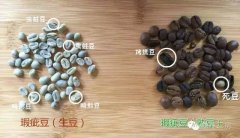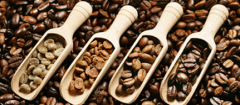The mystery of tea ceremony and meditation and the fashion of coffee boutique

For professional baristas, please follow the coffee workshop (Wechat official account cafe_style)
"I heard that coffee beans need to be fermented and stir-fried before drinking. When you bubble, you will fill the funnel with water in a circle. Isn't that very similar to the tea ceremony? " Drinks with tasty value include not only coffee, red wine, but also tea. The guests in front of them like to watch their colleagues focus on making hand-made coffee at the bar.
An appreciation Aesthetics
Since the rise of the wave of boutique, the public began to understand the original taste and brewing skills of coffee. From feeling the freshly ground dry powder fragrance, watching the cooking demonstration, to enjoying the taste changes when the liquid in the cup reaches the mouth. Boutique refers to not only coffee, but also a piece of appreciation aesthetics. It may be for this reason that it is reminiscent of the oriental tea ceremony, which also advocates craftsmanship.
I said, "I drink tea to understand thirst." Tasting tea is to appreciate the color, smell, water quality and tea utensils of tea. Tea art is a study of skills, which needs to be coordinated with environmental layout and background music. As for the tea ceremony, it is to integrate into philosophy and understand life through tea affairs. This hierarchical classification can probably also be used for coffee. What we pursue is to achieve stable extraction with scientific knowledge and technology, so that guests can feel the story behind every coffee farmer through the aroma of beans. This is an inside-out expression. The Japanese tea ceremony often refers to "a moment in a period", that is, tea waiters need to treat each tea service as an once-in-a-lifetime banquet, do not despise and make mistakes, and gain a sense of fulfillment of life from treasure and tension. This is introspection from the outside to the inside. "
The intersection of history
Coffee and tea have many interlaced points in history. The reason why Americans have regarded coffee as the drink of choice since independence is to get rid of the political implications behind black tea, which symbolizes the quintessence of British culture. In religion, coffee and tea are both refreshing and respected by spiritual practitioners. The taste of tea is insipid, in line with the monk's artistic conception of "purity and emptiness", so since the Tang Dynasty, the tea ceremony has been gradually integrated into Buddhism and Zen. The early spread of coffee depended on the spread among Islamic priests in the 16th century. Two kinds of drinks with very different tastes have spread throughout history, witnessing the enmity and feud of different times and religions. In modern times, coffee and tea are often paired with one of the two after a meal. Only in Hong Kong-style tea restaurants, where Chinese and Western cultures are mixed, can there be room for pre-meal Pu'er and post-meal "mandarin duck" (black tea and coffee).
The Western interpretation must be good?
A guest said, "with the same funnel and filter paper made in Japan, baristas in the United States rarely calculate current, water and time as you do." Once three of our friends ordered the same kind of coffee. If you were here, you would insist on making it. In order to save time, the American store put the powder of three people in a larger funnel and sprinkled it with water like pot irrigation. To make matters worse, he drove off after water injection! After a few minutes, other baristas passed by and saw the water dripping from the funnel and poured it into our cup. Don't ask what it tastes like. I don't want to drink it even if I see it. "
"it may be the dexterous handwork of oriental people and their obsession with craftsmanship. In Hong Kong, Taiwan, South Korea and Japan, when drinking hand-brewed coffee with relatively mild taste and bitter balance, we will also examine the level of extraction. This is impossible to quantify and difficult to score. So don't worship foreign countries blindly. With the same bag of coffee, we may have a completely different interpretation from the West. " I replied.
Patrick Tam (owner of the boutique coffee shop Knockbox, approved barista of the American Fine Coffee Association and European Fine Coffee Association, CQI recognized cup tester, Cup of Excellence's first Hong Kong judge)
MING PAO ARTICLE
Important Notice :
前街咖啡 FrontStreet Coffee has moved to new addredd:
FrontStreet Coffee Address: 315,Donghua East Road,GuangZhou
Tel:020 38364473
- Prev

What's the difference between fresh coffee beans and old beans?
Professional baristas Please follow the Coffee Workshop (official Wechat account cafe_style) Coffee enthusiasts gather at the shop every Friday night to taste the new coffee that comes on the shelves next week. Tonight, a self-baking enthusiast brought a handletter. This bag of 2012 Ethiopian Aricha coffee beans is a treasure that I have been reluctant to drink. I know you open baking every Friday.
- Next

Why can't raw coffee beans be mixed and roasted?
Professional baristas exchange, please follow the coffee workshop (Wechat official account cafe_style) Patrick, big deal! Just received a package from Central America, inside the original independent packaging of several bags of raw coffee beans were opened, messy mixed at the bottom of the box, the colleague angrily informed. Get justice for the beans! It has been more than a month since his visit to Central America. It is the harvest season, the fruit
Related
- Beginners will see the "Coffee pull flower" guide!
- What is the difference between ice blog purified milk and ordinary milk coffee?
- Why is the Philippines the largest producer of crops in Liberia?
- For coffee extraction, should the fine powder be retained?
- How does extracted espresso fill pressed powder? How much strength does it take to press the powder?
- How to make jasmine cold extract coffee? Is the jasmine + latte good?
- Will this little toy really make the coffee taste better? How does Lily Drip affect coffee extraction?
- Will the action of slapping the filter cup also affect coffee extraction?
- What's the difference between powder-to-water ratio and powder-to-liquid ratio?
- What is the Ethiopian local species? What does it have to do with Heirloom native species?

